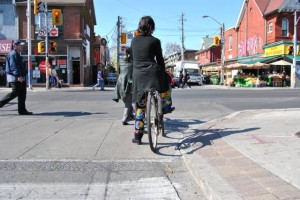By Jacob Arnfield
It’s no surprise that as the election year proceeds, the question of how best to improve our streetscapes is rearing its head.
Recently, the Board of Trade ranked Toronto’s long commutes worst among global cities of comparable size, the TTC is under heavy scrutiny, and bike lane proposals are being met with vehement support and vehement opposition.
While streetscapes include many different aspects, how and where to accommodate cycling on our streets has the greatest ability to turn animated debate into outright animosity—something many cycling advocates have come to lament.
Councillor Adam Vaughan (Ward 20, Trinity-Spadina) is a cyclist and a proponent of increase cycling infrastructure, but said he is not happy with how debate occurs. “I’m tired of this war on anything. It’s not a war on cars anymore than it’s a war on pedestrians, anymore than it’s a war on cyclists,” he said. “What it’s a war on is this unnecessary argument that one has to exclude the other. We can build complete streets, and balanced streets, and beautiful streets, but we have to be prepared to lead by design, and not simply create thoroughfares all the time giving priority to one form over another.”
Local cycling advocate Hamish Wilson, is one of the Annex’s loudest proponents of increased bike safety. He said he understands why the process can take time, but he says that regardless of the difficulties, it is crucial that critical pieces are built in the now, not ten years from now: first up is a safe route for cyclists travelling east/west through the Annex.
“I’m less dogmatic about ‘Must-have-bike-lanes-on-Bloor’ because obviously bike lanes can be contentious,” Wilson said. He added that because increased cycling infrastructure must necessarily disrupt either a traffic lane or street side parking so it can be accommodated, “a logical place to put it is parallel to the subway and it’ll help the subway as well.”
There are several new upgrades to cycling infrastructure planned for implementation this summer in the ward to be finalized at City Council this month.
The signed route on Harbord Street will be completed. Sharrows will be painted in the existing gaps and chevrons will be added through intersections.
Bike boxes—an intersection treatment that reduces conflict between cyclist and right-turning motor vehicles—will be installed on Harbord Street at the major intersections: Bathurst Street, Spadina Avenue, St. George Street, and Queen’s Park Avenue.
Regarding these improvements, Vaughan said, “We’re upgrading that facility to make it a strong cycling route and a safer one. It’s not perfect and you have to do these things in balance with competing interests.”
A potential lane on Bloor Street waits for the completion of a design proposal. As someone who has been involved in cycling advocacy for decades, Wilson is not confident these ongoing talks and plans will ever amount to significant upgrades. “Motorists tend to be pretty vocal and politicians tend to be on the craven side quite honestly for the most part. They’ll say good things about climate change and bike travel, but when it actually comes to putting facilities in where we need them it’s a different matter,” Wilson said.
Vaughan explained the lack of progress for a lane on Bloor Street during his first term. “The work wasn’t done between 2001 and 2006. We’ve started to get the work done. We’ve asked for the detailed plans to come forward. We’re acting on the recommendations, but when I took office in 2006 they hadn’t done the design work yet,” Vaughan said.
He emphasized the need for a strong design over “ad hoc white stripe painting” to accommodate all user groups on Bloor Street. As an example of the design challenges, he referenced the need to ensure the integrity of the pick-up and drop-off area for Senator D. Croll apartments (address), which complicates the design of the bike lane.
North-south trips have more minor upgrades heading to council this month. The proposal for a contra-flow lane on Brunswick Avenue has been deferred for 2010, due to local concerns over pedestrian safety and whether Brunswick Avenue is the best street for the proposed lane.
A new bike lane will be added to Spadina Crescent. The rest of Spadina Avenue from Bloor Street to Bremner Avenue will have the existing white lines, which are less than a metre from the curb, replaced with sharrows.
Additionally, there are bike lanes proposed for portions of Bay Street. The plan for Bay extends from Queen’s Quay West to Yorkville Avenue. Lanes will be included from Queen’s Quay to Front, from Dundas Street to College, and sharrows will be painted for the remainder of the route.
Bike lanes are not the only potential street improvements. The Harbord Village Residents’ Association (HVRA) spent four years working for wider sidewalks on College Street between Spadina Avenue and Bathurst Street and worked to create a trapping maze in the neighbourhood to slow down vehicle speeds along the long residential blocks between Harbord Street and College Street.
Gus Sinclair, who chaired HVRA while they worked for these improvements said, “We had a standing committee that basically fought with the city. The problem at that point was it took fourteen departments all not saying the same information … It was a byzantine Kafkaesque nightmare of trying to get something done, but in the end we got these really big sidewalks.”
Sinclair said the only way to accomplish their goals required “strong residents associations working in tandem with the councillor. Between the two of them you give the councillor political force to approach the individual city departments.”

